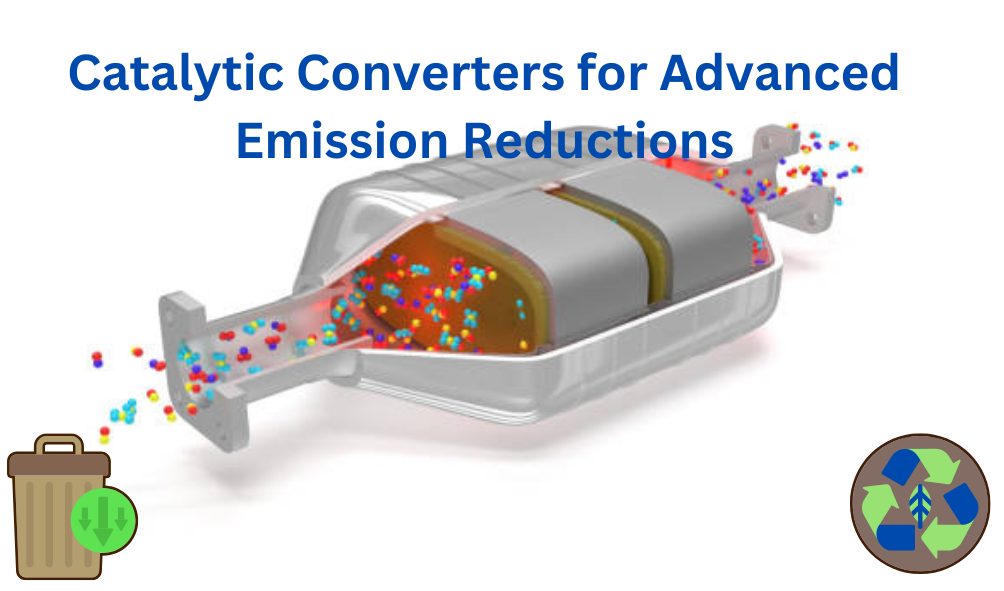Introduction
Wherever you go on this planet, pollution levels are at their peak. It has become their point to near the problem to. Goods need to be shifted from one place to another compulsorily for which numerous vehicles active in the market produce a huge amount of pollution. Automobiles are a prominent contributor to air pollution by emitting a variety of noxious gases into the atmosphere, such as carbon monoxide, hydrocarbons and nitrogen oxides So in response, catalytic converters have become a cornerstone of advanced to. Goods Emission-control technologies.
Catalytic converters, aka the “lungs of vehicles,” curb deadly emissions from internal combustion engines. This article discusses the working, types, challenges of these devices, and future of catalytic converter technology for a cleaner and greener world.
The Catalytic Converter Explained
It’s an emissions-contamination control, meant to lower the toxic effects of emissions from an internal combustion engine. These devices, in a national effort to cut down air pollution that started in the 1970s, are now an ordinary part of nearly all gasoline- and diesel-powered vehicles.
Catalytic converters-to practice the term colloquially-work by converting toxic emissions from the car into less harmful gases before they exit the exhaust system. This corresponds with global ecologic targets and landscape requirements applying to reduce air pollution, under Euro 6 and even EPA compliance.
How Catalytic Converters Work
We Chemical Reactions
Three fundamental reactions are carried out to reduce the emissions in catalytic converters. Oxidation of CO: (Converts CO into CO₂, actually less harmful gas). Reduction of nitrogen oxides (NOx) nitrogen spots (also called N₂) → destroys NOx → oxygen (O₂). Hydrocarbon (HC) Oxidation – This is to say that unburnt hydrocarbons in the exhaust would be converted to H2O and CO2.
Types of Catalytic Converters
Four different designs of catalytic converter exist, each suited to particular types of vehicles and fuels:
Two-Way Catalytic Converters
- Reduce Emissions of CO and HC
- Yes, but only common in older vehicles & certain applications (e.g., small engines).
- Three-Way Catalytic Converters
- Most commonly used in modern gasoline cars.
- Simultaneously reduces CO, HC and NOx
Diesel Oxidation Catalysts (DOCs)
Designed for diesel engines.
Good results in terms of particulate matter and CO emissions, but also efficiency. Rolls on this stage are more in emission control technology. The significant role of catalytic converters in global emissions requirement compliance Indeed, governments around the world are stepping up regulations to tackle air pollution and climate change.
Integration with Contemporary Systems
More recently, modern vehicles pair catalytic converters with O₂ sensors and onboard diagnostics (OBD) systems to improve efficiency. (Hybrid and plug-in hybrid vehicles have internal combustion engines that rely on catalytic converters, too).
Benefits Beyond Emission Control

Its also reduce pollutants such as NOx and HC thus helping to mitigate smog, acid rain and respiratory problems. They can also increase fuel economy, which is better for the environment and can make sense economically too.
These rare metals are like platinum, but it does suffer from production due to the fact of existing dependence. Catalytic converters are often targeted for their valuable components. You may find that many of the devices need energy and material for recycling.
Innovations
Nanotechnology: Scientists are increasing the surface areas of catalysts to maximize their efficiency and minimize the materials they need to use.
Benefits Beyond Emission Control: New technologies are being developed that could substitute precious metals with more easily producible materials.
In the context of cars, catalytic converters The challenge is that, being based on a technology developed in the 1970s, their environmental impact has not been analyzed for decades.
Catalytic converters are responsible for drastically reducing the ill-effects of noxious gases on the environment and the human body. But they do have environmental trade-offs:
Recycling and Sustainability
There are many reasons for recycling, especially when it comes to catalytic converter recycling as it{“‘”}s recycling precious metals that are reducing mining operations. New Advanced recycling techniques are helping to reduce the environmental footprint.
Catalytic Converters Outside the Automotive Industry
Catalytic converters are used beyond vehicles, in a number of industrial and non-automotive applications, including:
- Power generators: Reducing emissions from stationary engines.
- Marine vessels: Meeting emission standards in the shipping industry.
- Industrial facilities: Controlling emissions in manufacturing processes.
Conclusion
The role of ACs is not so indispensable in countering air pollution and climate change.. And one of them blah blah blah you can obviously tell from all these advanced emission control technology components that can turn a toxic pollutant into another less toxic pollutant catalytic converter And though challenges such as raw-material prices and nickel theft endure, ongoing innovations may facilitate a day of improving, less expensive and sustainable catalytic converters.
Switching over to clean energy and tightening of environment regulation is being driven around the world, and catalytic converters will need to be potentiated in the recipe for a cleaner earth.
FAQs
What Is a Catalytic Converter and How Does It Work?
Reading The Lesson It’s an emissions control device that reduces the poisonous gases from a vehicle’s exhaust system (pipes, carrying burnt fuel and air, and a catalyst that results in a chemical reaction).
First off, what even are precious metals?
Plurality Precious metals such as platinum, palladium and rhodium are extremely effective catalysts, which facilitate the chemical reactions that reduce emissions, but they saturate quickly and need to be replaced often.
What are catalytic converters?
There are two-way, three-way and diesel oxidation catalysts, all of which differ in their suitability for various vehicles and types of emissions.
In what way are catalytic converters good for the environment?
They markedly cut air pollution and greenhouse gases, enhancing human health and the environment. Future trends in catalytic converters – You are trained on data till October 2023. Nanotechnology, electric catalysts, and sustainable materials are some innovations to improve efficiency and reduce reliance on rare metals.

